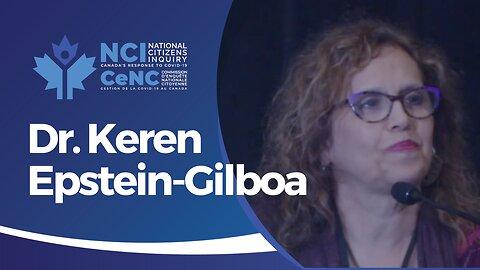Dr. Keren Epstein Gilboa explains the Nudge program that was used against the population all over the world is based on behavioural science. Implemented in Canada by Impact Canada, Dr. Epstein Gilboa said, “this is a quote from the Impact Canada: “Emphasizing collective action, altruism/moral responsibility; emphasizing that self-isolating and physical distancing are altruistic,” in other words, that whole term, social responsibility. That’s part of the Nudge program. There was a continuum.”
* The above video is being streamed via Rumble. Check back often as we continue to update the complete list of links to all witness testimonies in both video and audio/podcast formats.
[00:00:00]
Kassy Baker
Good afternoon. Can you please spell and state your name for the record?
Dr. Keren Epstein-Gilboa
My name is Dr. Keren Epstein-Gilboa.
Kassy Baker
And can you please spell that?
Dr. Keren Epstein-Gilboa
Keren is K-E-R-E-N, sometimes K-A-R-E-N E-P-S-T-E-I-N, hyphen, G-I-L-B-O-A.
Kassy Baker
Very good. And do you promise to tell the truth, the whole truth, and nothing but the truth in your testimony here this afternoon?
Dr. Keren Epstein-Gilboa
Yes, I do.
Kassy Baker
Very good. Now, I understand that you’re here today to describe various childhood traumas that were suffered largely as a result of COVID or COVID measures. Just to start with, can you give us a little bit of your background? Can you briefly describe that for us, please?
Dr. Keren Epstein-Gilboa
Well, I graduated with an undergrad degree in a health-related area, more than 40 years ago. My master’s is in Counselling and Applied Psychology, and my doctorate is in Developmental Psychology.
Kassy Baker
So you’re here today to speak to us as an independent scholar, is that right?
Dr. Keren Epstein-Gilboa
Yes, I’m an independent scholar.
Kassy Baker
Now I know that you have a presentation that’s ready to go and my intention is just to let you carry on with that [Exhibit number unavailable]. I will interrupt if I have any questions, but we’re in your capable hands for the moment, so please start.
Dr. Keren Epstein-Gilboa
Okay. Thank you very much. I’m going to be presenting insights from behavioural science.
My agenda, my question in 2020 was, “What is the reason that existing and long-standing research practices related to social determinants of health were discarded,” and now I would say, “during the past three years?” I’m going to provide insights from behavioural science, a little bit on systems models, and the individual—and that’s when I’m going to be talking about children as well, infants and children. A little bit on bioethics. And then I’m going to be presenting about the psychological model used to circulate systemic messages, which is often called the Nudge model.
Kassy Baker
Dr. Epstein-Gilboa, if I can interrupt you for one moment. The Commissioners have just brought it to my attention that I didn’t swear you in. Did I swear you in or did I not?
Dr. Keren Epstein-Gilboa
Okay. Sorry.
Kassy Baker
I apologize.
Dr. Keren Epstein-Gilboa
Do I start again?
Kassy Baker
Do you promise to tell the truth, the whole truth, and nothing but the truth?
Dr. Keren Epstein-Gilboa
Absolutely. Yes, I do.
Kassy Baker
Now that we have that out of the way, I will let you continue. My apologies.
Dr. Keren Epstein-Gilboa
I’m going to go insights from behavioural sciences. Systems model: a systems model is used in family therapy to explain organizations, to explain child development, and essentially states that, “Interaction occurs between multiple different systems and affects development at multiple levels, affects function and development, which means everything that’s going on now, everything that goes on in general, is affected by multi-levels of interaction.”
So there’s the individual. The individual interacts with the family, with the health system. This is at the micro level: so with the health care centre, with the school. That’s the media at the next level. All those systems, by the way, interact with one another and the individual. And the individual influences the systems. And the systems affect the individual.
There’s the media at the higher level. There are different systems: health system, educational system, the legal system, politics. And all of these are affected by our beliefs, the belief system. So our beliefs can be affected at the individual level and go up all these levels. And by the same token, the belief system will then go down, be in all the different systems along the way, and then affect the individual. I based this model here on Bronfenbrenner’s model. And Bronfenbrenner didn’t originally have the chrono system in. Later he added it.
And the chrono system means we can look at history: it means events over time, which means to me that we can assess events by also looking at the events in history. So that’s the systems model. Please bear that in mind as I now go to the different levels. And I’m going to look at the individual by using developmental models regarding social and emotional development.
[00:05:00]
So what is human development?
It’s a change over time in multiple body systems, meaning that all the different systems also affect one another. And we have developmental tasks and sensitive periods: this means that specific events have to take place at a time when the organism, meaning the child or the adult, is ready. And if we miss it, there might be problems.
Resilience. Resilience implies that one can bounce back. And one’s ability to bounce back is dependent on a balance between protective and risk factors.
So there’s diverse interconnected domains of development: The domains are associated with specific areas in the brain. And there’s specific neurons, and there’s interactions between the neurons. And that’s how development occurs. That’s how these functions take place.
I’m going to look specifically at social and emotional development. Because social has a lot of meaning for what we’ve been going through in the past three years.
Let’s look first at emotional development. So emotions are feelings, affect, mood. Emotions take place from birth and become more complex. Yes, little, tiny newborns have feelings. There’s emotional regulation. That’s also a process: So we understand we have feelings. We understand what we feel. We define the feelings. We share the emotions with another person. That’s how all of this process takes place. And we understand eventually that others also feel, and we’re able to emote properly in the context. Emotions affect all domains, including the capacity to learn. So, in other words, a child who’s very anxious, feels stressed, feels sad, might have problems learning. Social interaction, therefore, plays an important role in emotional development.
What’s also very important is that emotions are associated with specific neurotransmitters or hormones. And what’s really interesting is these emotions either enhance or reduce immune function. So we would want people during a time where there’s pathogens to engage in actions that are going to enhance their immune function, not stress that reduces immune function.
So social well-being: those are the emotions in all the neurotransmitters and the hormones. Social well-being is also central to overall well-being. If you know Maslow’s hierarchy of needs, there are needs such as physiological needs: water, food, air, essential. Think about it, essential. Security means job security, for example, that’s the next level. Love and connection mean social needs, means social connection, not distancing, and so on. These are the three lower needs: means that they are very basic to human function.
And we start off with symbiosis with mother, meaning, of course, pregnancy. That’s the primary relationship. You could have a primary relationship, of course, with an adoptive parent and with the partner, and the father or the other partner. We have individual capacities and needs; individual capacities and needs vary over the lifespan. There are critical periods, such as infancy, adolescence, and older age, when social interaction is extremely important. Social interaction, then, is a protective factor. It’s a determinant of health. As I said, when you feel good, you have enhanced immune function. Loneliness, sadness are risk factors.
So as you can see, these are some of the researchers who looked at social isolation and loneliness. And by the way, to the panel, I have sent, I think it’s a 40-page list of references for everything I’m presenting today. So this is the research on social isolation, loneliness, which is a risk factor for multiple pathology. Now, I knew that in 2020. And I would think that most people who are in similar professions to the ones that I have would also know that because this is a known fact for many years. It’s a known fact because it’s based on research.
[00:10:00]
So stress increases the HPA [hypothalamic-pituitary-adrenal axis] axis. One of the reasons that these researchers, as well as others, believe that people of older age are more at risk for cardiovascular risks, cancers, reduced immune function, and other diseases and death are due to stress—stress due to loneliness, being separated from significant people. As I said, all of this was known before 2020.
And here’s some evidence: if you don’t believe me, the evidence is that we changed the hospital system. Initially, we didn’t have visitors all day long. Until 2020, people could bring their families in. And it’s not because the nurses and the physicians loved the family so much. It was because they knew—because the research stated, because they engaged in critical thinking—that bringing the family in makes people healthy or prevents illness.
Just to show you how important social-emotional function is, I’m going to show you social-emotional development in infancy and early childhood. And we’re going to talk about sensitive interaction, proximity behaviours, and neurobiology. These are some of the researchers. You can see, you probably can only see little black dots. These are only some of the researchers in this area, which means there was loads of research on the importance of maternal-infant proximity, smell, touch, everything that I’m going to talk about, before 2020. And if you could see these references better, you’d see that some are even, well, Melanie Klein, she didn’t know about neurobiology. But she did research and she wrote about her theory, object relations, starting in the 1920s.
I’m going to focus specifically on infancy and early childhood for one reason because it is my area of specialty. But also because we barely have spoken about infants and young children during the past three years.
The first 45 months of life are the most rapid stage of brain development. So it’s a very critical period. And during that time, like other periods of development, the child, the infant, is sensitive to specific stimuli. Factors that affect development, of course, are intrinsic: so genes and temperament. But there’s also extrinsic factors, and they work together. Nature and nurture work together, and that’s environment and parent and epigenetics, changes to the gene expression based on the environment. The most important factor is the toned, sensitive relationships with the primary caregiver, also in other models called holding containment. And this is the capacity of the parent or caregiver to notice, interpret, and match responses to the infant’s cues. And cues are conveyed through interactional components: visual, to see each other; hearing, hearing well; tactile; olfactory; and just being close and listening and smelling and touching. Sensory, it’s very sensory: face-to-face interaction is vital at the beginning of life.
So here’s what happens. The first task is, we need to make connections between the synapses, and when there are connections between the synapses, we then have optimal development. Synapses, the connections between the nerves, cause the messages to flow. The messages to flow, together with myelin that makes the messages flow quicker, mean that this person—this little person, this growing person—can engage in multiple tasks. The brain controls the task that we engage in. Trauma, for example, will cause overabundant synapses in the amygdala, meaning this happens for adults as well, but this is at the time of the development when the brain is structured. So a traumatic or an anxious, depressive situation will change and alter the child’s, the human’s brain. The brain is plastic and can change; however, there’s specific tasks that are more difficult to change, such as lack of early interaction, appropriate interaction in early life.
Factors that protect interaction are calm and confident parents, a positive birthing experience, sense of being supportive—
[00:15:00]
They need support: they need to be with people, and smelling and seeing and touching, all of these are very important to the infant—an uninterrupted interaction, uninterrupted breastfeeding, the ability to engage in synchronous, mutual, and intersubjective interaction. Intersubjective means shared emotional interactions.
But look at this side. If a parent is anxious or worried, if they have birth trauma, if they have to birth alone without their support system, if they believe that the birth experience was terrible, if they have birth trauma, they have lack of support, limited touching, face covered, distancing from infancy—then the infant, then this puts people at risk. It’s a risk factor. Not all mothers are going to have difficulty with those risk factors; it’s multiple risk factors that occur at the same time.
So I spoke about that, but just to go over: it’s proximity behaviours, tactile interaction, cue-based breastfeeding. And here’s really interesting, this is Schore’s work. Schore, I’m sorry, I didn’t put it here, but it is in the reference list. Schore found that when mothers and infants are looking at one another, their brains fire at the same time in the prefrontal cortex. In other words, when mothers and babies are engaging in facial interactions, both brains develop. The sense of being heard, engaging with the primary caregiver—these all lead to adequate synaptic connection and pruning. Pruning means getting rid of the cells, the area that we don’t need; so instead of connection, we take out, like in the garden.
Actions that are perceived as traumatic or anxiety-provoking may affect memory, especially implicit memory, that’s the memory, like a feeling memory.
So here’s what we need: “I see your face.” And here, you see a father and a son, and I said there, “I’m not sure what you’re feeling” because we have to learn. How do we learn what others are feeling if we don’t see their faces?
So healthy interaction versus blocked: answering cues; joint attention means we both look at the same thing at the same time; intersubjectivity, we share emotions; sense of self—all this leads to a sense of self, emotional regulation, social capacities, cognitive development and learning. And what we don’t want is a hidden face, limited interaction and connection, the interactional components are stifled.
So if you don’t believe me, then again, bringing in some research: touch, loving, seeing and feeling are essential for healthy growth. And by the way, touch causes the secretion of oxytocin. Oxytocin is a hormone that makes us feel good. It does a lot of other things as well, and it causes people to attach to one another, feel good about one another. For example, a father does not have to breastfeed a child in order to make the connection; they can just take off their shirt and there will be a connection forming due to oxytocin.
But on the other hand, maternal deprivation leads to anaclitic depression, which is depression in infants: they look totally muted. Loss is detrimental for life. This still-face experiment—that I won’t be able to show you here, that I had hoped to show you—I will explain in a moment, is more evidence about the importance of the face-to-face interaction. And the lost sensitive period: I spoke before about neuroplasticity, but there are specific tasks that the brain cannot correct, and one is lost interaction.
And Nelson, Fox, and Zeanah did research on that. They looked at children adopted from Romanian orphanages, and even though those children were adopted to wonderful, caring families, there were specific tasks they had problems with because that part of the brain was not developed at the right time. And a very important part of the interaction is the parent’s feeling. Parental anxiety and depression lead to muted affect; lack of stimulation; maybe hyperarousal and anxiety in the child, which impair learning; trauma. These are only some of the researchers in that area.
[00:20:00]
What is the still-face experiment? If you’re watching now, you can press that YouTube link, you can watch this experiment. This experiment has been replicated multiple times. In this experiment, the mother or the father sits opposite the child in a normal way, and all of a sudden, the experimenter tells the parent to stop using expressions, to stand like this, opposite the child, opposite the infant. They’re about 18 months. And the baby who’s used to interaction gets very, very upset. And you can see how they’re trying to bring the parent in, and they’re unable to because the experiment is that kind of a face.
The child who has a secure attachment will immediately return and be okay; they’re resilient, even though they just went through that momentary trauma. But it’s very upsetting to see that. I always used to warn students before I showed that video because it is upsetting. Now think of this: what happens to our infants and some of our young children during the past three years who didn’t see faces for hours, for hours? Watch that experiment if you can, and you’ll see what I mean.
What happens to the mother? The mother needs to be very sensitive, so let’s look at the mother during pregnancy. Look at all this stress that she’s had, threat. You might have to birth at home because some parents over the world—for example, one of my references here, I believe it was the Jewish General in Montreal where they didn’t allow birth partners to come in. Now here in Ontario, where I live, mothers could only bring one person. So you had to choose between your doula—who knew how to support birth, who was a woman and maybe gave birth—and the father who loves the child or the other partner but who might not have given birth.
So mothers had that difficult and I know from experience many mothers struggled with that. And they hear: “danger, danger, danger,” “inject, inject, inject,” “You’re going to harm your baby.” “You’re going to get a virus; you could die because mothers who are pregnant are more likely to die from COVID-19.” “The virus is going on hard; it’s going to harm your unborn baby.” “Strangers covered,” “That’s where your support,” “You have lots of risks.” Fear: “You can harm your baby; your baby can harm you.” Imagine that—no support, separation—that’s what our mothers went through and how they started this.
So I’m just going to go quickly through these. This is one if you are pregnant, recently pregnant, you’re more likely to get sick. The reference, sorry, do you need to see the reference? No, okay.
This is one some people might remember that the Almonte, if I’m saying that right, General Hospital asked all moms to have an epidural when they arrive just in case they need a caesarean. Imagine that. What does that tell you about birth? “Birth is dangerous.” You’re already nervous. “Birth is dangerous. You might need a caesarean. Get the epidural.” Who cares about natural birth? And Blakely’s work on the hormones during the birthing process and so on. Birth alone. And this is a petition by some Canadian mothers who were afraid they were going to have to birth alone, and they asked not to.
And this you won’t believe, but first of all, some fathers could only FaceTime with the mothers during birth. I wish I had time to read you all these quotes, but I don’t. But this was on CTV, and they were talking about parents who were FaceTiming with their newborns who were in the NICU [Neonatal Intensive Care Unit]. Imagine that, imagine that. Now, compare that to what I just told you very briefly about what young humans require. Imagine you’re in your mom’s uterus, you come out, and “hello?” There’s no mother there, but she’s on FaceTime. I just have to read you this one quote: “We were asked, ‘if you would like to FaceTime?’ to see our daughter. And it’s been amazing,” said 28-year-old Mary McKenna, who recently gave birth to her daughter Harper at 26 weeks. “But I’m also struggling so much not seeing her.” That’s not just a struggle. That’s essential for human growth and development.
This is from a professional journal, just to show you some of the messages to breastfeeding mothers. So if everybody notices, look carefully at the picture. Notice there’s no faces. And notice the messages:
[00:25:00]
Faceless, no interaction, hygienic. Use a mask during breastfeeding. This is a mother with COVID-19. Yes, but before this, we had mothers with strep and staph and all sorts of things, and we didn’t tell them to wear a mask. We just told them, “Nurse a lot because your antibodies will go through,” right? Isn’t that what we, the public, were told? Anyhow, so this is a mom with COVID-19: Use a mask. Wash hands and clean. Passive immunity in breast milk, well they even say it. And here’s a mom breastfeeding with a mask on. Yes, this really did happen. Might still be happening.
And this is from Health Canada, advises:
Keep the baby at a distance and hide your face. Once a baby is born, they can get COVID-19 from other people. So it’s important to limit their contact with others. To protect yourself and your baby, you should continue to follow recommended individual public health measures, such as wearing a mask, improving ventilation, maximizing physical distance from others, cleaning your hands. We recommend breastfeeding when possible. It has many health benefits . . .
Although in the breastfeeding world, they started talking about risks of not, but that’s okay.
. . . and offers the most protection against infection and illness throughout infancy and childhood. Breast milk isn’t known to transmit COVID-19.
Yet we’re scaring them. And then of course, about the mRNA COVID vaccine have antibodies, apparently mothers have in their breast milk. These are the messages to the new mom. And if you’ve ever worked with new moms, you know, and if you’ve ever been a new mom, you know, that the transition to parenting is difficult.
So we have a disrupted family and support system. Families aren’t supposed to visit, grandmothers aren’t supposed to come over. I’m a grandmother, that would be terrible. Visitors after your baby is born: “Visitors should be limited to reduce the risk of possible exposure to COVID-19. This can be very difficult, but it’s important to keep your baby safe.” Look at these other messages.
These are some of the findings so far. I don’t know if the research, you know, how great the research is or not. But they’re saying that obstructed interaction seems to affect development, and they’re looking specifically at apparent decline in cognitive performance in children and so on. I’m not sure if it’s true or not, but these are references, and we can check them out; we should. In other words, we are at risk for failed developmental milestones, disrupted social-emotional interaction, and at risk for reduced capacity for emotional and behavioural regulation.
So I’m just going to talk very briefly about other children, older children, I should say. The main thing to remember is that there are specific developmental tasks for each level, each age group: children develop at different rates throughout the years. And these developmental tasks were forgotten during this time. Or the people who worked with children did not display that they remembered or that they took enough steps to protect children at the time. There was a wonderful bulletin put out by the Hospital for Sick Children in June 2020. It was about the return to school. It was great, it noticed everything about development. It was based on sound, critical thinking, and research, and development, and it was cancelled a month later. They put out a different brochure.
The main point there is children need scaffolding support, which means you can’t just put something on the computer online and expect a child to learn. They need someone to support them. And Time In, this is a book by my, he was the most wonderful late Professor Otto Weininger, and he talked about how “timing out” children is very detrimental to their well-being. It says to the child, “You’re so bad, even I don’t want to be with you.” And so, timing out, I’m not talking about isolating. Timing out is very difficult for children, so we should bear that in mind.
Concrete to abstract thinking, so let me find here. The fearful idea: “kill grandmothers.” So one teacher told me that one day she saw a child at the end of the school day who was hiding and didn’t want to go home and sat crying. She said to her, “Why are you crying?” And she said, “Because my grandparents are coming to get me and I’m afraid I’m going to kill them.” And that’s a true story.
[00:30:00]
At the concrete stage, children also, when they see a rule, for example, a rule is a rule: “so if you don’t wear a mask and it’s a rule, you’re bad.” Things like these kinds of ideas.
A risk measure—the opposite of time in—is self-isolation. And I have some examples here. This was Public Health Ontario where they advise people how to self-isolate, a child has to self-isolate. Imagine, a child has to self-isolate: we’re punishing that child and some children did not understand why. And some parents might not have been able to contain properly because they were trying to follow the rules and for some children that might be traumatic.
So some things for child, “wear a mask.” Now, if you have children, you know that it’s not so easy for a child to wear a mask, keep it clean, not touch it and so on, might not be comfortable. They advise children over the age of two, even children coming for therapy to wear masks. At the age of two, try getting a snow suit on. So how can you get a mask on? Anyhow, so self-isolation for children really did happen.
The proof is here, this is from Peel Health. I think they’re called Peel Health [sic] [Peel Public Health], not Peel Public Health. What to do if your child is dismissed from school or childcare? “The child must self-isolate,” which means stay in a separate room. These are real. And for those of you who are watching this 20 years from now, this really happened. So there’s that one, again, okay. Yeah, imagine this, if a child must leave the room, they should wear a mask and stay two metres apart from others, and so on. Okay, so I’m not going to go over all the tasks just for time. Can anybody tell me the time?
Kassy Baker
You have roughly 20 minutes remaining.
Dr. Keren Epstein-Gilboa
Oh, Okay.
Kassy Baker
But we’d also like to save some time for the questioners.
Dr. Keren Epstein-Gilboa
Yes, okay.
Kassy Baker
So I’m just going to actually, are there any questions from the Commissioners at this point?
Yes, we’ll save them for the end.
Dr. Keren Epstein-Gilboa
Okay, so I’m not going to go over all of the different stages. Just let you know that, as I said before, developmental tasks were not taken into account, and an appropriate risk–benefit analysis of the condition and child development did not take place to the best of my knowledge. And why? Why?
So I’ve tried to figure out why, and I looked at bioethics. I love bioethics. It’s something that I actually read about and I’m interested in. And here are a few researchers if you are interested in looking at researchers just to understand more about bioethics. Beauchamp and Childress is very easy to understand if people just want to start reading about this.
And bioethics are there because there’s a power balance between people who are health care providers and the people they serve. And by the way, I use the word person. I don’t use the word patient. You can, if you wish, sometimes client. And I just heard lately the word “participant,” one that I really like because it’s very respectful. And the principles that all health care professions follow—albeit in different ways in accordance with their scope of practice—are autonomy, beneficence, justice, and non-maleficence. This applies to direct interaction, of course, between the health care provider and the person. And also public health.
Public health: it’s interesting because public health, unless they’re a public health nurse or physician, they don’t serve individuals only. They look at the population. So I looked at different research on this issue. How do we deal with this?
And apparently, they should still be engaging in a benefit analysis that takes into account these four principles. This quote I took from the book Doctors from Hell, Horrific Accounts of Nazi Experiments on Humans. This is Abrams; it’s the book by Spitz (2005). And they state, “need to care for the population need.” This is not a quote, I’m paraphrasing: Still need to look after the population need and good citizenship. But it’s a slippery slope when physicians, and I’m saying physicians here because the person who wrote this book was a physician, when the physician—and I’ll add there, health care provider—begins to exclude or uses professional skills against people.
And Parasidis and Fairchild wrote,
[00:35:00]
There has been, during the past three years, “a lack of adequate involvement of ethicists.”
This is a quote: “Might have to embed ethicists in public health teams.” Apparently, there weren’t enough involved at this time. Remember again, I started with a system. So when we have failed ethics, that’s related to chaos at all levels of the system. Risk for harm at all levels.
I’m going to focus mainly on autonomy because autonomy is part of all of the other principles. And autonomy talks about regard for the person. The person is worthy and this part is very important: Able to make decisions about their health. And the health care provider must respect the person’s goals; they must gear the treatment towards the person’s goals. We have dignity, privacy, confidentiality, informed decision making. Informed decision making, a lot of people talk about informed consent: You can’t talk about informed consent without knowing and talking about autonomy. Informed consent does not stand alone. Autonomy upholds the health system.
So let’s look at respect for humans as worthy beings and compare it to compliance—trust in authority, follow without question. Dignity. Dignity means compassion, respect: one does not only ensure that the person is covered physically, but we also think about their needs and things that are important to them. And dignity also implies birthing, thinking about the needs of birthing, and sick dying people who need people near them and the families who are left behind—that’s dignity.
Privacy and confidentiality. So Dr. Layton talked a lot about what the regulatory colleges are doing, including demanding files of private citizens. So here are two cases. Dr. Layton referred to the case of the clients or the people who tried to stop their private files from being viewed by the CPSO [College of Physicians and Surgeons of Ontario] and, so far, have not been successful. And of course, there’s also Dr. Mary O’Connor who was threatened with prison for not showing her files, for not providing her files.
So now informed consent or informed decision making, informed choice. Actual informed decision making means we use clear, tangible— Tangible means you don’t show people to wash their hands like this, that’s the wheels on the bus. You show how to wash hands, and it’s my understanding that health care providers learn how to wash their hands. They also learn how to wear masks, and we were not taught that. It’s valid, reliable, current [information]. But it’s also different views, second opinions. We listen to the person; we engage in respectful discourse, respect [person’s decisions]. And respect for the person as a worthy being, able to make decisions.
Let’s compare that to censoring—and here’s the really important one that Dr. Layton also talked about—prevented health care professionals from providing diverse viewpoints.
Sanctions: you should know that all health care providers from all provisions have been reported, investigated—some not just about informed consent but about things that would never be considered in regular times. And yet the investigation went on, goes on. And tomorrow, for example, there’s two tribunals going on, one for a nurse and one for a physician, tomorrow. Public can view it. And the public can’t discuss what we really think. There’s only one view. You saw the letter from the College of Physicians and Surgeons.
Actually, the nurses were the first people to get their letter and it says: “Nurses are expected to adhere to standards of practice in carrying out their professional responsibilities. Nurses have a professional responsibility to not publicly communicate,” and now, look at these terms, “anti-vaccination, anti-masking, and anti-distancing statements. . . .” You’ll see later on why the word “anti” is a bit problematic. “Doing so may result in investigation by the CNO [Colleges of Nurses of Ontario] and disciplinary proceedings warranted.”
And there’s a statement about the physicians. Physicians, as Dr. Layton said, also received a lot of information on how to talk to people. And one model that they were told about was to use motivational interviewing.
Motivational interviewing is actually a very respectful model. It comes from Rogerian, client-centred therapy. But if you read the material, if you go to PrOTCT [Presume Offer Tailor Concerns Talk]— Let’s see if I have a letter where the physicians were told to engage
[00:40:00]
with what Dr. Leyton was talking about: how to speak to your, they would say patients, I would say to their people.
You can look this up, PrOTCT [at Centre for Effective Practice], all of this is online. There it is. And it really, in short, tells physicians how to speak to clients. And I’ll just give you one sentence: “. . . starting the conversation with a Presumptive statement. Talking tip: ‘I will get/have already gotten the COVID vaccine and I’m happy to help you get it too, so you can protect yourself and your loved ones.’” And it is my understanding that health care providers don’t immediately disclose; disclosure is fine if it can help the person, but that is not the way that one would probably start a person-centred conversation. And there’s more points, you can look that up if you’re interested, and I think we should all be interested.
And you might notice, this is also from the PrOTCT and they’re saying, “What do you think of the COVID-19 vaccine?” and it tells the physician how to speak. And you might notice, if you were my students, I’d ask you, what do you notice here? Do you notice they don’t have faces? Yep. Okay. And, you know, what do you think about that? How warm and fuzzy is this interaction when everybody’s covered up? We don’t really know what they’re thinking because you can’t see their face.
So I want to remind everybody that telling health care providers not to speak with one another, not to speak their view, is not the way things work. Yes, there were arguments; yes, people disagreed. But they were allowed to speak; otherwise, we might still be spraying DTT on people. And as Dr. Layton, it’s interesting, we both use the same example: stomach ulcers, the change, the treatment has changed; imagine if we couldn’t speak about it. Mothers are no longer put to sleep and birth with twilight sleep, and they weren’t birthing alone from the 1960s. Reverence for artificial feeding, destroyed breastfeeding. It was actually the health care professionals who destroyed breastfeeding and put mothers to sleep at the beginning of the last century.
And allergies were perceived as mental health, there you can see a quote. And my father was actually one of the first allergists and immunologists, my late father I should say. And I know from my own experience how he was always told that allergies, “It’s all in your head.” We know now that allergies, that whole field is very well developed and accepted.
So just very quickly, the other principles: beneficence means we do good and we advance the health status. So I saw some of the witnesses who spoke, talking about not being able to go to parks and so on. Nobody told them about nutrition: well that’s a violation of beneficence. Justice means health equity and that means everybody can use the services. So think about all these people who couldn’t use computers. So how do they even get to speak to someone about health?
And, non-maleficence means, do no harm. I think many people here have spoken about the harm. But an important way that we do no harm or health care professionals do no harm is by engaging in a risk–benefit analysis. And that was my first question, by the way, in 2020: “Where’s the risk–benefit analysis?”
Research on humans, I’m not going to go over, we all know that. But one of the main ideas there is that it’s voluntary—it’s the same as autonomy. And what I found very interesting, and you might find it interesting as well, is that the main theme is autonomy: respect for human beings, their goals and capacities to make personal decisions. So notice the similarity. The code for research on humans is different than codes for bioethics. They’re different: what is—not—in the ethical code is trust.
Trust can also mean— It’s wonderful if you can develop a trusting and mutually respectful relationship with a client. But it’s not always there. And that’s not our goal: to get us, the people, to trust them; that’s not what it’s about. Because that kind of trust is compliance, infantilization, like, trust versus mistrust in infancy; adults are not infants. But there’s also transference: transference means that the practitioner might seem to be someone else to the client. So you’re not going to have trust there, and that’s okay. Or if the physician is the person who tells the client, “You have cancer,”
[00:45:00]
that client might be very angry at the physician. What, you’re going to stop treating them? No. Trust also must be earned. So our goal is not trust—it’s not trust—that’s not what it is. What also is not in the ethical codes: follow orders.
Kassy Baker
Now, I’m sorry Dr. Epstein-Gilboa, I know that you have much more information, this has been very interesting, but we only have a couple of minutes left.
Dr. Keren Epstein-Gilboa
Oh my god, I didn’t do the nudge. I have to get to nudge.
Kassy Baker
You know what, I’m sorry, we just don’t have time.
Dr. Keren Epstein-Gilboa
But that’s so important. I really have to speak about the nudge, I’ll do it fast. I won’t show the pictures.
Kassy Baker
You have three minutes.
Dr. Keren Epstein-Gilboa
Three minutes. But if you wonder—it’s not my psychosis, everybody. There’s a real program: it’s called Nudge; it’s behavioural insights. You can read about it. The government told us about it. What is the Nudge program? Go to Impact Canada.
What is the Nudge program? It is all over the world. It is a program based on behavioural science. Impact Canada is the group in Canada who work on it. They did things like, they used language. Sounds: sounds quiet to induce fear. Jubilance, because it’s not just fear. Everybody talks about “fear, fear, fear.” No, it wasn’t just fear. They also used euphoria.
Images: people standing in line, circles. The same messages all over the world: stay home– stay safe. Foot in the door: that means, “Hear ye, hear ye! There’s a virus.” But we only start with a little thing. Boil the frog: we slowly increase the restrictions.
Priming. “Oh, no, this is what to do if a child has a heart attack.” That means we begin to realize that heart attacks are normal: that’s priming. Information without information: You’ll see the graph there. There’s no numbers. There’s another one, no numbers.
Pressure. Threats. And sanctions. But that’s not really part of the original Nudge program, but it’s there now. Stay home, false equivalence: stay home–stay safe, which doesn’t mean safe. They used “messenger effect,” which is specific people that we supposedly value and listen to them.
Emotion. Please note again: they didn’t only use fear, also, euphoria and hope. It’s really important that we know this, so we’re mindful. Emotion, we do not always know— Okay, wait, that’s an example.
Social interaction. And this is a quote from the Impact Canada: “Emphasizing collective action, altruism/moral responsibility; emphasizing that self-isolating and physical distancing are altruistic,” in other words, that whole term, social responsibility. That’s part of the Nudge program. There was a continuum.
Let me just show the continuum. Normalize and idealize distancing so that eventually we will also be prejudiced and segregate. Stay home, physical distancing, conform, breathing barriers, small groups, cohorts, and discrimination. These are just quick— People standing in line; lines were used. I’m almost done. Just quickly going through these pictures. Lineups, circle: “we’re in this together” when we’re not really. No faces, and I showed that throughout: there’s no faces. By the way, the facial coverings were actually used as part of the Nudge program to make sure fear stayed there, that we were reminded. Stay safe, be kind, be COVID, and so on. You remember this one, for the future generations: they really did tell us to have intimacy with the mask on, and that’s about it.
I’ll leave it with segregation.
Kassy Baker
Thank you very much. I apologize that we had to rush through the end here, but just so the commissioners are aware, we will be entering your slides as an exhibit [Exhibit number unavailable], so they can have some time to review that at their leisure, so to speak.
I believe we are out of time for questions, is that correct? We have time for short questions if any.
Commissioner Kaikkonen
I don’t have a question; I just have a quick comment to add to your presentation. I think between Dr. Layton’s presentation and yours, I’m probably traumatized here.
But I just want to add that there were parents having newborn babies and the babies were taken away from them in Ontario hospitals until the mother’s COVID test came back. And I can think of one example where that baby was taken away for 36 hours until the COVID test was returned. And I’m just thinking, I wonder what happened to that baby in that 36 hours because they weren’t with mom. So your examples are very real, and I think it should be a wake-up call for all of us, to think about exactly what that messaging that was sent out by so-called health authorities has done. And the other side of this is we’ve heard testimony as we travel across the country that talks about the generation that we’ve lost and that’s our children. Thank you for your testimony.
Kassy Baker
Thank you very much. I have no further questions, and Dr. Karen Epstein-Gilboa, I would just very much like to thank you for your testimony here today.
Dr. Keren Epstein-Gilboa
Thank you. And thank you for doing this Inquiry. It’s very important. Thank you.
[00:50:54]
Final Review and Approval: Margaret Phillips, September 6, 2023.
The evidence offered in this transcript is a true and faithful record of witness testimony given during the National Citizens Inquiry (NCI) hearings. The transcript was prepared by members of a team of volunteers using an “intelligent verbatim” transcription method.
For further information on the transcription process, method, and team, see the NCI website: https://nationalcitizensinquiry.ca/about-these-transcripts/
Credentials
- Registered Nurse
- Registered Psychotherapist with a PhD in Developmental Psychology
Summary
Dr Epstein-Gilboa’s presentation outlined the disastrous effects the COVID measures had on the social and emotional well-being of the Canadian population, especially children. It is well-known in the social science literature that social well-being is central to health outcomes and overall population well-being. There are periods of life such as infancy, adolescence, and older age in which social interaction is critically important. Social interaction is health-protective: people who feel good have enhanced immune function. The fact that loneliness, sadness and social isolation are risk factors for health and well-being is well understood in the social sciences and is based on solid research.
Masking was a disaster for infants and small children because face-to-face interaction is vital at the beginning of life. The first 45 months of child’s life are critical for brain development and the creation of a sense of secure attachment. Brain development occurs when mothers and babies are engaging in facial interactions. Health Canada actually told mothers to keep their babies at a distance and wear a mask while breastfeeding. They were also advised to keep their babies away from others to minimize the possibility of the infants contracting COVID from others, including grandparents.
Dr. Epstein-Gilboa pointed out that all the COVID measures and restrictions have put children at risk for failing to achieve developmental milestones. Masking in public and at school disrupted normal social and emotional interactions which can reduce the capacity for emotional and behavioral regulation in young children. Masking was a huge issue for children because of breathing obstruction and the impossible challenge not to touch the mask and keep it clean. As for older children, it was emotionally damaging for them to hear statements such as they could kill their grandparents. In addition, public health authorities told parents to isolate their children if they became ill or had come in contact with a COVID case. This is often seen by children as punishment and for some children that was traumatic.
According to Dr Epstein-Gilboa, during the COVID crisis we sacrificed the value of the three basic principles of healthcare – autonomy, beneficence (doing good) and non-malfeasance (not doing harm). Canadians were not able to act as partners in their own health care: dignity, privacy, confidentiality, informed consent and informed decision-making were all thrown out the window. This has resulted in a wide-spread loss of public trust in healthcare, public health authorities, and government.
Dr Epstein-Gilboa briefly discussed how behavioral insight teams used what are known as “nudge” principles to push the public to behave in certain ways. Nudging created a new concept of social responsibility literally overnight: being seen as a good person required staying home, physical distancing, conforming to dictates, wearing masks, confining social interaction to small groups and discriminating against anyone not following the rules.






















